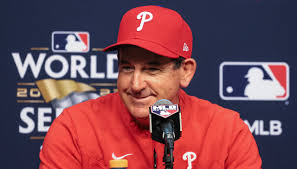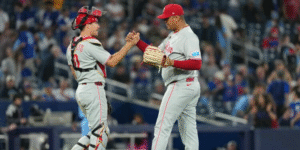
Philadelphia Phillies Restructure Bullpen, DFA Carlos Hernandez in Strategic Shifts
By Sports Correspondent – June 12, 2025
Toronto, Ontario – June 3, 2025. Carlos Hernandez, wearing No. 35 for the Philadelphia Phillies, was captured on camera sharing a victorious moment with veteran catcher J.T. Realmuto after closing out a tense ninth inning against the Toronto Blue Jays at Rogers Centre. The win, however, would be one of his last contributions in a Phillies uniform, as just over a week later, the organization made a major decision to designate him for assignment—a clear signal that the team is willing to make difficult choices to reshape its bullpen for the remainder of the season.

Philadelphia’s Mission to Reinforce the Bullpen
The Philadelphia Phillies have been on an aggressive path toward strengthening their pitching staff, particularly the bullpen—a part of their roster that has shown signs of vulnerability throughout the 2025 season. Their mission is clear: to craft a bullpen unit that can provide stability, consistency, and confidence in the final innings of a game.
This long-term vision took a significant turn when the Phillies officially designated relief pitcher Carlos Hernandez for assignment (DFA), ending his brief tenure with the team. While such decisions are common in Major League Baseball, the DFA of Hernandez marks a notable moment in Philadelphia’s broader bullpen overhaul, and it demonstrates the club’s readiness to turn the page when expectations aren’t met.
From High Hopes to Disappointment: The Hernandez Experiment
When the Phillies acquired Carlos Hernandez off waivers from the Kansas City Royals earlier in the season, the move was seen as a low-risk, high-reward gamble. Hernandez was known throughout the league for his raw power on the mound—his fastball frequently touched triple digits, and his off-speed repertoire included a biting curveball and a developing slider. At 27 years old, with previous experience in high-leverage situations, he appeared to be an ideal candidate to bolster the Phillies’ bullpen depth.
Unfortunately, reality didn’t align with those optimistic projections.
Though Hernandez flashed his signature velocity at times, his inconsistency quickly became a concern for the coaching staff. Over the course of 25 appearances this season, he posted an underwhelming 5.26 ERA, allowing 13 walks in just over 25 innings. His command issues led to a high number of base runners, putting additional stress on the defense and contributing to blown leads and late-game collapses.
Despite glimpses of promise, his inability to throw strikes consistently and get outs in key moments ultimately sealed his fate.
Opening the Door for New Talent: Enter Michael Mercado
In a decisive move following Hernandez’s DFA, the Phillies promoted Michael Mercado from their Triple-A affiliate in Lehigh Valley. For Mercado, the call-up represents a career milestone—his first opportunity to pitch in the major leagues.
Mercado has been quietly progressing through the Phillies’ farm system and was widely regarded as a promising arm with a refined approach to pitching. Though not as flashy as Hernandez in terms of raw velocity, Mercado’s strength lies in his control, pitch sequencing, and mental poise—qualities that the current Phillies bullpen has sorely needed.
Team insiders have suggested that Mercado’s recent performances in Triple-A—highlighted by a sub-3.00 ERA and solid strikeout-to-walk ratio—were what ultimately earned him this shot at the big leagues. His promotion is more than just a routine roster change; it’s an investment in a new direction, reflecting the Phillies’ commitment to rebalancing their bullpen with more dependable arms.
A Season of Bullpen Woes and Rebuilding
The Phillies’ bullpen has been under the microscope all season. While the team has enjoyed offensive surges and strong outings from their starting rotation, the relief corps has repeatedly struggled to hold leads and close out games cleanly. These shortcomings have cost the team valuable wins and exposed gaps in roster construction.
Philadelphia’s front office, led by President of Baseball Operations Dave Dombrowski, has made it clear that mediocrity won’t be tolerated. The DFA of Hernandez is a continuation of this no-nonsense approach. It follows previous moves such as optioning underperforming pitchers, testing out young prospects, and using bullpen days to recalibrate workloads.
This proactive mindset underscores an organizational awareness: In a competitive National League landscape, where every win counts and playoff margins are razor-thin, the bullpen must be a source of strength—not uncertainty.
Why Hernandez Didn’t Fit the Puzzle
Carlos Hernandez arrived in Philadelphia with potential, but his struggles weren’t just statistical. According to team sources, coaches noted issues with mechanics and consistency during bullpen sessions. Despite efforts by pitching coach Caleb Cotham to tweak his delivery and restore his confidence, Hernandez failed to find the rhythm needed to become a reliable contributor.
Moreover, Hernandez’s velocity, while impressive, came without movement or deception at times, allowing hitters to time their swings. He gave up multiple hard-hit balls in pressure situations and lacked the ability to pitch effectively with runners on base. These deficiencies were exacerbated in close games, further eroding the trust of the coaching staff.
There’s also the broader reality of Major League Baseball today: Triple-digit heat alone no longer guarantees success. As hitters become more accustomed to high velocity, it’s the pitchers who combine command, movement, and pitch sequencing that rise above.
Mercado Represents a New Direction
Michael Mercado’s addition is about more than just filling a roster spot—it’s symbolic of a philosophical shift. In recent years, the Phillies have been criticized for relying too heavily on veterans or reclamation projects rather than nurturing their farm system talent. Mercado’s call-up bucks that trend.
With a deliberate windup and a mid-90s fastball that he pairs effectively with a sharp breaking ball and occasional changeup, Mercado may lack the power profile of Hernandez but brings much-needed control and adaptability. If he performs well, he could anchor a new-look bullpen that blends youth with experience.
The coaching staff plans to use Mercado in lower-leverage situations initially, allowing him to acclimate to major-league hitters without the pressure of late-inning responsibilities. Still, the door remains open for him to earn a bigger role if his performance warrants it.
Fan Reactions and Organizational Insight
Reactions to the DFA of Hernandez have been mixed among fans. Some were excited by his raw talent and disappointed that things didn’t work out, while others applauded the organization for taking swift action. Social media was filled with debate over whether the team gave him a fair shot, or whether the Phillies’ bullpen environment simply wasn’t the right fit.
Internally, team officials have reiterated that decisions like this are always difficult but necessary. The primary focus remains the team’s success in the present, even if that means parting ways with players who were once seen as high-upside assets.
It’s possible that Hernandez, now on waivers, will catch on with another club—perhaps one in need of bullpen depth and willing to take another chance on his electric arm. But for the Phillies, the chapter is closed, and the focus shifts fully to the next man up.
The Bigger Picture: Phillies’ Bullpen Future
Looking ahead, the Phillies are clearly aiming to mold a bullpen that is not only statistically improved but also mentally resilient. With division rivals like the Braves and Mets fielding potent offenses, every late-inning decision becomes critical. To contend in October, Philadelphia knows it must field relievers who can withstand pressure and deliver consistent results.
Michael Mercado isn’t expected to be the savior—but he represents the kind of strategic, calculated risk the team needs to take. Other young arms in the system, such as Orion Kerkering and Andrew Baker, could soon follow, signaling a youth movement designed to establish long-term reliability.
Meanwhile, veterans like José Alvarado and Seranthony Domínguez continue to provide leadership and experience. The hope is that the right blend of emerging talent and proven relievers can finally give the Phillies the bullpen foundation they’ve lacked in recent years.
Conclusion: Change, Though Difficult, Is Necessary
The Philadelphia Phillies’ decision to designate Carlos Hernandez for assignment isn’t just about one player’s struggles—it’s about the organization’s broader mission to compete at the highest level. In a sport where success often hinges on razor-thin margins, having a dependable bullpen can mean the difference between contending and collapsing.
As the Phillies continue to evaluate talent, make tough decisions, and build toward a sustainable future, one thing is clear: they’re no longer content with hoping for improvement—they’re actively demanding it.
The message to players and fans alike is unmistakable: Perform, adapt, or be replaced. And for the 2025 Phillies, that message could be the key to unlocking postseason success.
Leave a Reply